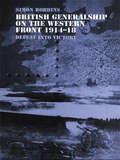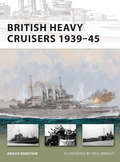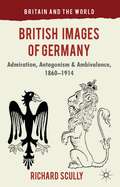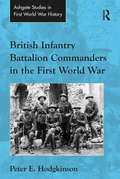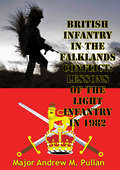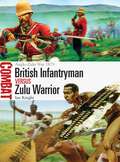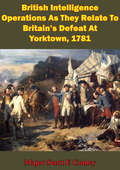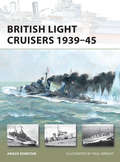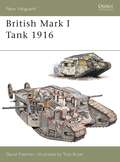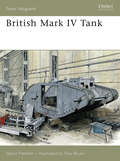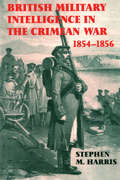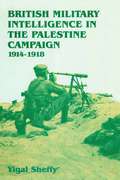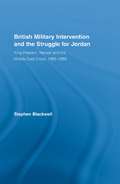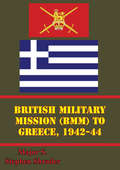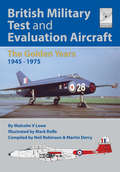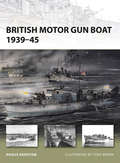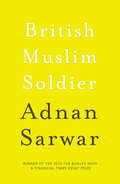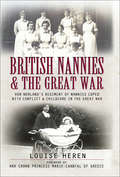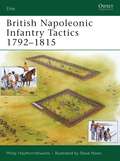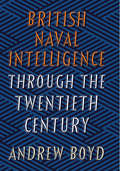- Table View
- List View
British Generalship on the Western Front 1914-1918: Defeat into Victory (Military History and Policy)
by Simon RobbinsThis book explores the British Army's response on the Western Front to a period of seminal change in warfare. In particular it examines the impact of the pre-war emphasis on worldwide garrison, occupation and policing duties for the Empire's defence of the mindset of the Army's leadership and its lack of preparation for a continental war involving a massive, unplanned increase in men and material.The reasons for the poor performance in the early years of the war, notably professionalism within the British Army, including poor staff work, 'trade unionism', careerism within the high command, and the tendency of an overconfident hierarchy to ignore the need for reform to tackle the tactical stalemate prior to 1916, are analysed. The high command rapidly learnt from the defeats of 1915-16 and performed much better in 1916-18, an especially formative period resulting in the promotion of a younger, more professional leadership and the development of the first truly modern system of tactics which has dominated wars ever since. During 1917-18 the Army's commanders and staff evolved and improved these new methods; developing a doctrine of combined arms to overcome the tactical stalemate bedevilling Allied offensives.
British Governance Of The North-West Frontier: A Blueprint For Contemporary Afghanistan? (1919 To #1947)
by Major Andrew M. RoeFrom the conclusion of the Third Afghan War (1919) to India's Independence (1947), Great Britain governed the wild, mountainous territory of the North-West Frontier that borders Afghanistan. This control used a variety of mature political and military structures to successfully administer the tribal areas.The challenges faced by the British in the North-West Frontier are comparable to current problems the coalition and North Atlantic Treaty Organization face in Afghanistan.Looking at British solutions to similar problems in the same geographical area, albeit from a different era, has clear utility.This thesis provides a historical overview of Colonial India, reviews the political and military structures employed in the North-West Frontier (1919 to 1947), and discusses the current warfighting and reconstruction challenges faced in Afghanistan. It also identifies the pertinent lessons learned from the British experience that are transferable to settling the conflict and furthering the national reconstruction of Afghanistan. The thesis concludes by combining the lessons learned into a coherent four-step plan for the reconstruction of Afghanistan.
British Heavy Cruisers 1939-45
by Paul Wright Angus KonstamThe idea of a heavy cruiser emerged in the aftermath of the First World War, and was closely linked to the limits set by the inter-war Washington Treaty on naval armament. The pre-Great War concept of armoured cruisers had been abandoned, but in their stead the Admiralty saw a place for powerful cruisers, able to patrol the sea lanes of the British Empire, and which were well-enough armed that they could destroy enemy commerce cruisers of the kind used by the Germans in the last war.The result was a group of British warships which were collectively known as the "Washington Treaty Cruisers", which did everything the Admiralty wanted, but which fitted within the limits imposed by the Washington Treaty - an armament of 8-inch guns, and a displacement of less than 10,000 tons. These impressive cruisers were high-sided, spacious and stately - perfect peacetime ambassadors for British power. In war they also packed a considerable punch. While they all carried powerful 8-inch guns, they were also given an effective armoured belt, making them proof against any foreign cruisers then in service. During the Second World War the Royal Navy's thirteen heavy cruisers saw service in every theatre of war, whether taking part in major sea battles in the Mediterranean, delivering the coup de grace to the Bismarck in the North Atlantic, or enduring the unwanted attention of kamikaze pilots in the Pacific.
British Images of Germany
by Richard ScullyBritish Images of Germany is the first full-length cultural history of Britain's relationship with Germany in the key period leading up to the First World War. Richard Scully reassesses what is imagined to be a fraught relationship, illuminating the sense of kinship Britons felt for Germany even in times of diplomatic tension.
British Infantry Battalion Commanders in the First World War (Routledge Studies in First World War History)
by Peter E. HodgkinsonRecent studies of the British Army during the First World War have fundamentally overturned historical understandings of its strategy and tactics, yet the chain of command that linked the upper echelons of GHQ to the soldiers in the trenches remains poorly understood. In order to reconnect the lines of communication between the General Staff and the front line, this book examines the British army’s commanders at battalion level, via four key questions: (i) How and where resources were found from the small officer corps of 1914 to cope with the requirement for commanding officers (COs) in the expanding army; (ii) What was the quality of the men who rose to command; (iii) Beyond simple overall quality, exactly what qualities were perceived as making an effective CO; and (iv) To what extent a meritocracy developed in the British army by the Armistice. Based upon a prosopographical analysis of a database over 4,000 officers who commanded infantry battalions during the war, the book tackles one of the central historiographical issues pertaining to the war: the qualities of the senior British officer. In so doing it challenges lingering popular conceptions of callous incompetence, as well more scholarly criticism that has derided the senior British officer, but has done so without a data-driven perspective. Through his thorough statistical analysis Dr Peter Hodgkinson adds a valuable new perspective to the historical debate underway regarding the nature of British officers during the extraordinary expansion of the Army between 1914 and 1918, and the remarkable, yet often forgotten, British victories of The Hundred Days.
British Infantry In The Falklands Conflict: Lessons Of The Light Infantry In 1982
by Major Andrew M. PullanThis study investigates the Falklands Conflict from the perspective of the light infantry to determine the key lessons that they learned during the ground campaign. These lessons are then applied to the British Army, specifically the infantry, at the turn of the century to determine if they are still relevant.The Falklands Conflict represents the last experience that the British infantry has of fighting in the light role in conventional warfighting. This thesis postulates that there were some critical failings in the infantry performance in the Falklands, mainly due to a lack of training because of a lack of time spent in the light infantry role.This study analyzes the ground campaign from the landings at San Carlos to the final battles around Port Stanley. From this study six broad lessons were identified, three of which are unique to this thesis and concern the use of ad hoc formations, the light infantry load, and the impact of the Regimental System on infantry performance in the Falklands Conflict. The study then concludes by discussing the relevance of all the identified lessons to the infantry at the turn of the century. The conclusion of this study finds that many of the factors that led to the problems experienced by the infantry in 1982 and hence to their lessons from the ground campaign are as relevant today as they were in the Falklands Conflict.
British Infantryman vs German Infantryman
by Peter Dennis Stephen BullThis engaging study pits the volunteers of Kitchener's 'New Armies' against the German veterans who defended the Somme sector in the bloody battles of July-November 1916. The mighty struggle for the Somme sector of the Western Front in the second half of 1916 has come to be remembered for the dreadful toll of casualties inflicted on Britain's 'New Armies' by the German defenders on the first day of the offensive, 1 July. The battle continued, however, throughout the autumn and only came to a close in the bitter cold of mid-November. The British plan relied on the power of artillery to suppress and destroy the German defences; the infantry were tasked with taking and holding the German trenches, but minimal resistance was anticipated. In the event the defences were damaged but not destroyed, and small numbers of defenders, many of whom had garrisoned the Somme sector for many months and knew the ground well, inflicted appalling casualties on the British attackers. Both sides incurred major losses, however; German doctrine emphasised that the first line had to be held or retaken at all costs, a rigid defensive policy that led to very high casualties as the Germans threw survivors into ad hoc, piecemeal counterattacks all along the line.Featuring specially commissioned full-color artwork and based on meticulous reassessment of the sources.
British Infantryman vs Zulu Warrior
by Peter Dennis Ian KnightExpert ananlyis and first-hand accounts of combat during the Anglo-Zulu war in 1879: Nyezane, iSandlwana, and Khambula. As seen in the movie Zulu, starring Michael Caine, Zulu discipline and courage overcame British firepower at iSandlwana, and almost at Rorke's Drift. Featuring specially commissioned artwork, expert analysis and carefully chosen first-hand accounts, this absorbing study traces the development of infantry tactics in the Anglo-Zulu War by examining three key clashes at unit level.The short but savage Anglo-Zulu War of 1879 pitched well-equipped but complacent British soldiers and their auxiliaries into combat with one of history's finest fighting forces, the Zulu Nation. The clashes between these two very different combatants prompted rapid tactical innovation on both sides, as the British and their Zulu opponents sought to find the optimal combination of mobility and firepower.Fought on 22 January 1879, the clash at Nyezane saw Zulu forces, among them the uMxapho ibutho, ambushing a British column; the British forces, including Lieutenant Martin's company of the 2/3rd Foot, engaged their opponents in the prescribed fashion, as honed in the recent conflict with the Xhosa a year earlier. The Zulu attack was premature, and by 9.30am, after about 90 minutes of heavy fighting, they were repulsed. The British tactics worked, but largely only because the Zulus had an uncharacteristically low numerical superiority.At iSandlwana later that same day, however, the shortcomings of the British tactics, obscured at Nyezane, were made brutally apparent. The Zulus had sufficient manpower not only to withstand that level of casualties but also to complete their encirclement of the British forces, and as the British line disintegrated the firefight gave way to the close-quarter fighting at which the Zulus excelled; not one man of the 1/24th and 2/24th Foot survived. The British forces surrounded and crushed at iSandlwana included Captain W.E. Mostyn's company of the 1/24th Foot, which was initially deployed in advance of the British camp but was later withdrawn to form part of the firing line; their opponents included the iNgobamkhosi ibutho, many of whose warriors left first-hand accounts of the battle.While iSandlwana demonstrated the strengths of the Zulu tactics, it also demonstrated their weaknesses - for the casualties inflicted by the British foreshadowed the carnage they would reap once the British wholeheartedly embraced close-order tactics and defended positions. At Khambula on 29 March 1879, a much bigger British force adopted a defensive position and defeated the same Zulu units who had previously triumphed at iSandlwana, including the uKhandempemvu ibutho, which came close to storming the British defences. At iSandlwana, the Zulus had been able to screen their advance with skirmishers and take advantage of the broken and grassy ground, but at Khambula their spontaneous attack did not allow them to disperse properly and they were funnelled together on a contracting front over woefully exposed ground. The British had learned the tactical lessons of iSandlwana and deliberately sought to restrict the Zulu ability to manoeuvre and co-ordinate their attacks, and to concentrate their own firepower.
British Intelligence Operations As They Relate To Britain's Defeat At Yorktown, 1781
by Major Scott E. ConleyThis paper examines the role of British intelligence operations during the American Revolutionary War as they apply to the British defeat at Yorktown. It begins with a brief history of British intelligence prior to the war, discusses strategic collection against the burgeoning French-American alliance, examines preconceptions during the planning of the southern campaign, and analyses the tactical intelligence operations of Lord Charles Cornwallis' army from the British victory at Charleston in 1780, through the defeat at Yorktown in 1781. It concludes that at the strategic level British intelligence accurately monitored French assistance to the Americans but had difficulty using the information to effect meaningful action on the American continent. At the operational level, General Sir Henry Clinton developed an accurate, reliable intelligence system in the northern colonies but was unable to transfer those successes to the southern theater. At the tactical level, General Cornwallis suffered from initial misconception about the degree of loyalist support in the South, lacked a general knowledge of the physical terrain in the southern colonies and failed to conduct proactive, deep reconnaissance during operations.
British Light Cruisers 1939-45
by Paul Wright Angus KonstamCruisers became Britain's essential vessel for protecting battleships, carriers, and convoys versus Japanese, Italian, and Nazi German commerce raiders, submarines, aircraft, and destroyers. The light cruiser was a natural development of the sailing frigate - a fast multi-purpose warship that could patrol the sea lanes, protect convoys and scout for enemy battle fleets. By the inter-war period the need for this type of ship was even more important, given the increasing need for protection from aircraft, and the need to screen the fleet from submarines or destroyers. During the 1930's a new group of British light cruisers were commissioned, designed to replace an earlier generation of warships designed during the Great War. These new ships were sleek, fast, and relied on the 6-inch gun - a tried and tested weapon that combined hitting power with a high rate of fire. A second generation of light cruisers followed during the late 1930's, armed with twelve 6-inch guns apiece. One of these - HMS Belfast - is still afloat today. Finally the threat posed by German aircraft led to the conversion of some older warships into anti-aircraft cruisers - a stopgap measure until a new class of these powerful and much-needed warships entered service. By this time wartime experience had shown that the British light cruiser was one of the most versatile types of ship in the Royal Navy, able to protect other warships, bombard enemy shores, guard life-saving convoys and intercept and destroy enemy warships. These were truly the workhorses of the wartime Royal Navy. While the battleships and carriers grabbed the headlines, these sleek, elegant warships quietly got on with the job of securing control of the seas.From the Trade Paperback edition.
British Light Cruisers: Leander, Amphion and Arethusa Classes (ShipCraft)
by Les BrownThe ‘ShipCraft’ series provides in-depth information about building and modifying model kits of famous warship types. Lavishly illustrated, each book takes the modeler through a brief history of the subject, highlighting differences between ships and changes in their appearance over their careers. This includes paint schemes and camouflage, featuring color profiles and highly detailed line drawings and scale plans. The modeling section reviews the strengths and weaknesses of available kits, lists commercial accessory sets for super-detailing of the subjects, and provides hints on modifying and improving the basic kit. This is followed by an extensive photographic gallery of selected high-quality models in a variety of scales, and the book concludes with a section on research references – books, monographs, large-scale plans and relevant websites. This is the first of two volumes covering Royal Navy 6-inch cruisers of the 1930s and later, this one devoted to three related designs armed with twin mountings. This group includes some of the most celebrated ships of the Second World War, like Ajax, Achilles, Penelope and the Australian Sydney. The next volume will feature the later classes armed with the triple 6-inch mounting – the ‘Towns’, ‘Colonies’ and their derivatives. With its unparalleled level of visual information – paint schemes, models, line drawings and photographs – this book is simply the best reference for any modelmaker setting out to build one of these famous cruisers.
British Light Tanks 1927-45
by Henry Morshead David FletcherThis is a definitive study of key British tanks from the early part of the Second World War. These types saw active service with the British Expeditionary Force in France, with British Forces in the Western Desert and in India. They also took part in the campaigns in Norway, Persia and Sumatra as well as serving with the Garrison of Malta. The German Army modified a lot of these tanks for their own use, tanks that they had captured in France while others were adapted as anti-air craft tanks or fitted with special flotation devices. Some Mark VI series light tanks were also issued to Australia and Canada while a slightly modified version was supplied in large numbers to India where they were used on the North West Frontier. The book also examines the Marks that led up to the VI and chronicles various experiments carried out on these tanks, with text and illustrations. It ends with coverage of the final model, the MarkVIC and details of the experimental Lloyd airborne Light tank of 1942 which has a number of features in common with the better-known Vickers-Armstrongs designs.
British Mark I Tank 1916
by Tony Bryan David FletcherIn 1915 a machine christened Little Willie changed the way that wars were fought. Little Willie was a fully tracked armoured vehicle that could break a trench system. Its development was completed in December 1915, but by then it had already been superseded by an improved design, Mother. This was the first rhomboid tank, and the prototype for the Mark 1 which would influence a whole generation of tank building. This book details the development of the Mark I, and its surprise arrival in France in the middle of 1916 during the closing weeks of the battles of the Somme.
British Mark IV Tank
by Tony Bryan David FletcherThe formidable Mark IV tank was pitted against the German Army from 1917 until the end of World War I. This book reveals the important role the tank played in the historic battle of Cambrai in 1917 as well as the first ever tank-versus-tank actions against German A7Vs. In awe of British technology, the Germans actively captured, salvaged and repaired Mark IVs for deployment against the Allies. Using rare photographs and detailed artwork, David Fletcher explores the Mark IV's design and development, its variants and accessories, and brings to life its exciting deployment on the battlefields of World War I.
British Military Intelligence in the Crimean War, 1854-1856 (Studies in Intelligence)
by Stephen M. HarrisThis is a study of the British military intelligence operations during the Crimean War. It details the beginnings of the intelligence operations as a result of the British Commander, Lord Raglan's, need for information on the enemy, and traces the subsequent development of the system.
British Military Intelligence in the Palestine Campaign, 1914-1918 (Studies in Intelligence)
by Yigal SheffyShortly after the end of the First World War, General Sir George Macdonagh, wartime director of British Military Intelligence, revealed that Lord Allenby's victory in Palestine had never been in doubt because of the success of his intelligence service. Seventy-five years later this book explains Macdonagh's statement. Sheffy also adopts a novel approach to traditional heroes of the campaign such as T E Lawrence.
British Military Intervention Into Sierra Leone: A Case Study
by Major Walter G. RobersonThis paper is a case study of the British military intervention into Sierra Leone in 2000. The successful British intervention led to defeat of the Revolutionary United Front (RUF), final peace accords, and brought order to a failed state. The paper will explore the following points: what was the British foreign policy and what impact did it have in the decision to intervene; what was the British counterinsurgency (COIN) doctrine and was it useful for the forces in Sierra Leone; did the British forces use their own doctrine or was the situation in Sierra Leone unique; why was the intervention successful and what lessons can be drawn? Beyond the scope of this paper is a comparison of United Kingdom (UK) COIN doctrine and current United States (US) COIN doctrine. The focus will be to analyze the UK's actions against their doctrine, not the doctrine of the US. There is one major assumption for this case study. The paper categorizes the intervention into Sierra Leone as successful. The justification for the assumption is current day Sierra Leone. Instead of a war torn failed state, Sierra Leone has lasting peace, completed disarmament of insurgent forces, ended the large scale human rights abuse, and democratic elections, not coups, determining the leadership of the country.
British Military Intervention and the Struggle for Jordan: King Hussein, Nasser and the Middle East Crisis, 1955–1958 (British Politics and Society)
by Stephen BlackwellWithin two years of their abortive invasion of the Suez Canal zone in 1956, British troops once again intervened in a major Middle Eastern country. The Jordan intervention of July 1958 took place despite the steady decline of the British position in the country over the previous three years. This book examines why the government led by Harold Macmillan remained ready to use military force to prop up the regime of King Hussein even though the United States had emerged as the main Western power in the Middle East after 1956. Incorporating a variety of archival material, Blackwell provides new historical insights into the origins of the Anglo-American use of military power to protect their interests in the Middle East.
British Military Mission (BMM) To Greece, 1942-44
by Major S. Stephen ShraderThe study of insurgency and counterinsurgency over the years provides a valuable tool for analysis in the current Global War on Terrorism. Failure to take into account and accurately assess political and military actions in such environments can lead to unintended consequences (potential civil war) affecting the stability of a country. Accurate assessment of the political and military actions does not guarantee success or failure, as every insurgency is a unique case, which requires observation and analysis through the strategic implications particular to each circumstance. One historical example for analysis is the British Military Mission (BMM) to Greece in 1942-44, which begs the question "did the policies utilized by the British in balancing the opposing political and military objectives of rival guerilla forces delay or help bring about the Greek Civil War?" This monograph explores the question by analyzing the historical documentation of actual events that transpired during the mission and whether they delayed or help bring about the Greek Civil War.
British Military Test and Evaluation Aircraft: The Golden Years 1945–1975 (Flightcraft Ser. #18)
by Malcolm V. Lowe&“An attractive book . . . chock full with photos and drawings of all the planes that have been drawn and built in these years in the UK.&” —AviationBookReviews.com It could be argued that the heyday of British military aircraft flight testing began in the 1940s, and continued throughout the three decades that followed, during the so-called Cold War period. As such, the authors have purposely chosen to focus on the first 30 years, The Golden Years, 1945 to 1975, from the end of World War Two until the mid-1970s. This was arguably the most exciting period with many wonderful and new types rubbing shoulders with wartime and immediate postwar designs that were utilized for development purposes, making for an eclectic mix of shapes and color schemes. Alongside the technical aspects of military testing and development, are the many and varied color schemes and markings carried by the aircraft themselves—not only by the brand-new experimental designs, but by existing production machines, suitably modified, to greater or lesser degrees, to develop the technical advances in systems and weaponry. Scores of different aircraft types are covered in British Military Test and Evaluation Aircraft: The Golden Years 1945-1975, with over 65 rarely seen contemporary photographs from private collections, and, differing slightly from previous Flight Craft book formats, over 50 pages of specially commissioned full color profiles and plan views, visually chronicling the diverse range of color schemes and markings applied to these fascinating airplanes. &“The development of British military aircraft is examined in extraordinary and fascinating detail in Malcolm Lowe&’s spectacular book.&” —Books Monthly
British Motor Gun Boat 1939-45
by Tony Bryan Angus KonstamDuring World War II, few groups within the Royal Navy fought a harder, more intense war than the men of Coastal Forces. Their job was to operate the Motor Torpedo Boats (MTBs), Motor Launches (MLs) and Motor Gun Boats (MGBs) that protected coastal convoys, attacked enemy ones, and performed a myriad of duties, which include the dropping of agents and commandos on a hostile shore, raids on enemy ports, and near-suicidal attacks on larger enemy warships. While the MTBs were the "bombers", delivering their payload of high explosive torpedoes, the crew of the MGBs used their machine guns and small-calibre guns to sink, burn or destroy their enemy counterparts. For that reason they saw their frail, sleek craft as the "Spitfire of the Seas". Motor Gun Boats were similar to Motor Torpedo Boats, only their decks were crammed with as many guns as they could carry - and to man these weapons, they required a larger crew. During the early years of the war, they were used to counter the threat posed by German E-Boats in the English Channel, but by 1941 they were in use offensively, conducting sweeps along the enemy coast in search of prey. By 1942 British MGBs were seen in the Mediterranean, interdicting Axis supply routes to North Africa, and later supporting the Allied invasion forces as they landed in Sicily, Italy and the South of France. The majority of these small wooden craft were built in Britain by the British Power Boat Company or Fairmile Marine. They came in a variety of shapes and sizes, but in late 1942 the Fairmile "D" MGB made its appearance - a boat which would come to dominate coastal operations during the last years of the war. Known as "Dog Boats" by their crew, they were fast, powerful and versatile. By the end of the war, over 200 of these small boats had been built and they represented the pinnacle of wartime British motor boat design.This New Vanguard title tells the story of these fragile but deadly little warships.
British Muslim Soldier
by Adnan SarwarIt isn't nice but you're an animal, so you can do it, dressed in green and brown and black waiting to be attacked and smiling because you had bullets for teeth. Adnan Sarwar, a Pakistani boy from Burnley, joined the British Army – the White Man’s Army. Why did he do it? To prove he was as white as his friends? For Queen and Country? Or to work out who he was – British, Muslim or a Soldier? Perhaps he could be all three. ‘British Muslim Soldier’ is Adnan’s journey through the battlegrounds of war, race and identity, facing up to the often brutal realities of these fraught warzones. There is racism, family ties, tedious routine, enemies and torture. But what Adnan’s story really comes down to is love – love for his family, for his fellow squaddies – and a deep-rooted sense of identity and belonging. …when did these clothes fit so well? When did Corporal become an older brother and when did the army become a mother? When did I become a British soldier?
British Nannies & the Great War: How Norland's Regiment of Nannies Coped with Conflict & Childcare in the Great War
by Louise HerenIn 1912, Norland childrens nurse Kate Fox was travelling by train heading to the British military station at Nowshera on the Afghan border to care for the premature baby born to the bases commanding officer. Two years later, Kate was escaping from Germany in the first days of the Great War, leaving behind her adored German royal charges and all her personal possessions. Due to their prestige as the crme-de-la-crme of Edwardian childrens nurses to Europes royal and wealthy families, Kate was one among many Norland nannies who witnessed the early days of the War on the Continent with all its tumult and fear. Some fled for home; others managed to stay for a while. And yet others gave up their privileged way of life to undertake war work as nurses in Flanders and refugee camps.The stories in this book are the nannies eye-witness accounts described in their correspondence with their beloved Norland Institute. These previously unpublished letters recount a version of womens Great War history that has remained untold until now. British Nannies and the Great War is the true story of a group of Edwardian, highly trained and opinionated women in the First World War. For the first time in a century, the Norland nannies unique stories of escape from enemy territory, their experiences at home and the Front during the War, and their thoughts on how the conflict changed their role in post-Edwardian Britain are told in their own words.
British Napoleonic Infantry Tactics 1792-1815
by Steve Noon Philip HaythornthwaiteOsprey's study of Britain's infantry tactics used during the Napoleonic Wars (1799-1815). The British Army's major campaigns against Napoleon were fought between 1808 and 1813 in the Peninsula (Portugal, Spain, and finally southern France), followed in 1815 by the brief but climactic Waterloo campaign. The British Army was small by continental standards, but it consistently out-fought larger French armies, never losing a major open-field action. Its cavalry and artillery were standard; but its infantry which unlike foreign armies, was entirely made up of volunteers, achieved unique results. Their tactics were brought to a peak of professional perfection by Wellington, but commentators still consistently over-simplify the explanation for his unmatched series of victories. This book will examine the contemporary instruction manuals, and compare them with what actually happened in specific battles, drawing upon a mass of quotations from eyewitnesses. Under other generals who failed to grasp the essentials, the British infantry could be beaten (occasionally) by both the French, and by the Americans; but it was Wellington's perfect employment of their tactical strengths that made them unstoppable. With a detailed look at the effective use of terrain, line vs column maneuvers, and fortification assaults, Philip Haythornthwaite reveals the outstanding tactics of Wellington's army that converted volunteers into war-winning professionals.
British Naval Intelligence through the Twentieth Century
by Andrew BoydAn acclaimed military historian examines the vital role of British naval intelligence from the mid-nineteenth century to the end of the Cold War.In this comprehensive account, Andrew Boyd brings a critical new dimension to our understanding of British naval intelligence. From the capture of Napoleons signal codes to the satellite-based systems of the Cold War era, he provides a coherent and reliable overview while setting his subject in the larger context of the British state. It is a fascinating study of how naval needs and personalities shaped the British intelligence community that exists today.Boyd explains why and how intelligence was collected and assesses its real impact on policy and operations. Though he confirms that naval intelligence was critical to Britains victory in both World Wars, he significantly reappraises its role in each. He reveals that coverage of Germany before 1914 and of the three Axis powers in the interwar period was more comprehensive and effective than previously suggested; and while British power declined rapidly after 1945, the book shows how intelligence helped the Royal Navy to remain a significant global force for the rest of the twentieth century.
